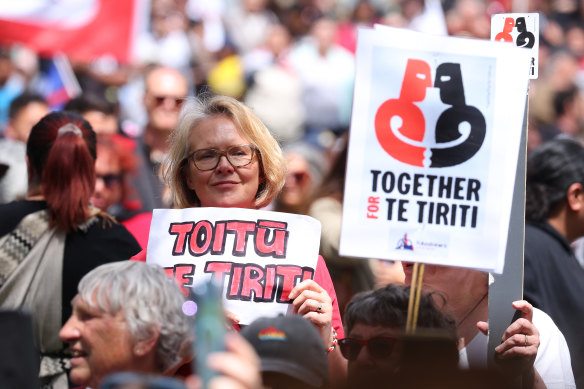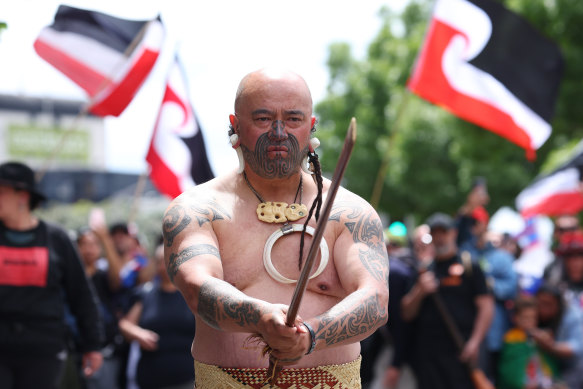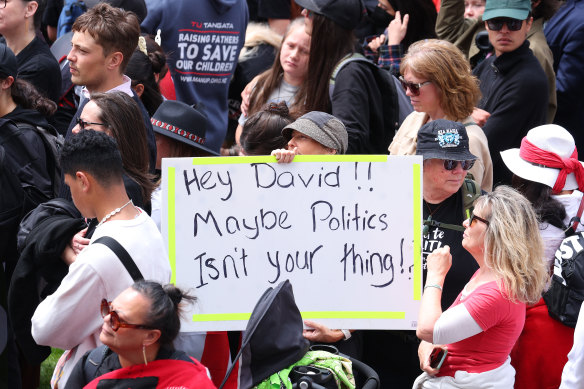Why are thousands of people marching for Maori rights?
By Charlotte Graham-McLay
Wellington: A proposed law that would redefine New Zealand’s founding treaty between the British Crown and Maori chiefs has triggered political turmoil and prompted 42,000 people to show up in protest at the country’s Parliament on Tuesday.
The bill is never expected to become law. But it has become a flashpoint on race relations and a critical moment in the fraught 180-year-old conversation about how the country should honour its promises to Indigenous people when the country was colonised – and what those promises are.

March participants congregate outside parliament in Wellington, NZ, on Tuesday. The hīkoi has travelled for nine days across the country to protect and advocate for the Treaty of Waitangi and Māori rights. Credit: Getty Images
Tens of thousands of people gathered in the capital, Wellington, for the final stretch of a week-long protest that has spanned the length of the country – a march through the city streets to parliament. It follows a Maori tradition of hikoi, or walking, to bring attention to breaches of the 1840 Treaty of Waitangi – and is likely to be the largest treaty rights demonstration in the history of modern New Zealand.
Some placards bore jokes or insults about the MPs responsible for the bill, but others read “proud to be Maori” or acknowledged the bearer’s heritage as a non-Maori person endorsing the protest. Some denounced the widespread expropriation of Maori land during colonisation, one of the main grievances arising from the treaty.
“The treaty is a document that lets us be here in Aotearoa so holding it up and respecting it is really important,” said Ben Ogilvie, who is of Pākehā, or New Zealand European, descent, using the Maori name for the country. “I hate what this government is doing to tear it down.”
Police said 42,000 people tried to crowd into the parliament’s grounds, with some spilling into the surrounding streets. People crammed themselves onto the children’s slide on the lawn for a vantage point; others perched in trees. The tone was almost joyful; as people waited to leave the cramped area, some struck up Maori songs that most New Zealanders learn at school.
Why is a 180-year-old treaty being debated?
Considered New Zealand’s founding document, the treaty was signed between representatives of the British Crown and 500 Maori chiefs during colonisation. It laid out principles guiding the relationship between the Crown and Maori, in two versions – one in English and the other in Maori.

Thousands of people gather outside New Zealand’s parliament on Tuesday to protest a proposed law that would redefine the country’s founding agreement between Indigenous Māori and the British Crown.Credit: AP
It promised Maori the rights and privileges of British citizens, but the English and Maori versions differed on what power the chiefs were ceding over their affairs, lands and autonomy.
Over decades, the Crown breached both versions. By the mid-20th century, Maori language and culture had dwindled – Indigenous people were often barred from practising it – tribal land was confiscated and Maori were disadvantaged in many metrics.
How were treaty rights revived?
Prompted by a surging Maori protest movement, for the past 50 years the courts, MPs and the Waitangi Tribunal – a permanent body set up to adjudicate treaty matters – have navigated the differences in the treaty’s versions and tried to redress breaches by constructing the meaning of the treaty’s principles in their decisions.

Maori rights have been protected by the 1840 Treaty of Waitangi, signed between the British Crown and NZ’s Maori leaders.Credit: Getty Images
Those principles are intended to be flexible but are commonly described as partnership with the Crown, protection of Maori interests and participation in decision-making.
While Maori remain disenfranchised in many ways, the weaving of treaty recognition through law and attempts at redress have changed the fabric of society since then. Maori language has experienced a renaissance, and everyday words are now commonplace – even among non-Maori. Policies have been enacted to target disparities Maori commonly face.
Billions of dollars in settlements have been negotiated between the Crown and tribes for breaches of the treaty, particularly the widespread expropriation of Maori land and natural resources.
Why is there fresh debate?
Some New Zealanders, however, are unhappy with redress. They have found a champion in MP David Seymour, the leader of a minor libertarian political party, ACT New Zealand, which won less than 9 per cent of the vote in last year’s election – but scored outsized influence for its agenda as part of the governing coalition. He is minister for regulation.

Hikoi members protest the bill introduced by MP David Seymour, leader of ACT NZ.Credit: Getty Images
Seymour’s proposed law would set specific definitions of the treaty’s principles, and would apply them to all New Zealanders, not only to Maori. He says piecemeal construction of the treaty’s meaning has left a vacuum and has given Maori special treatment.
His bill is widely opposed – by left and right-wing former prime ministers, 40 of the country’s most senior lawyers, and thousands of Maori and non-Maori New Zealanders who are walking the length of the country in protest.
Seymour’s bill is not expected to pass its final reading. It cleared a first vote on Thursday due to a political deal, but most of those who endorsed it are not expected to do so again. The reading of the bill was disrupted by a haka performance by Maori MPs, video of which went viral around the world.
Detractors say the bill threatens constitutional upheaval and would remove rights promised in the treaty that are now enshrined in law. Critics have also lambasted Seymour – who is Maori – for provoking backlash against Indigenous people.
Why are protesters marching?
Peaceful walking protests are a Maori tradition and have occurred before at crucial times during the national conversation about treaty rights.
Police in the country of 5 million said more than 35,000 people thronged parliament’s grounds on Tuesday after a march through the central city that shut down streets and drew thousands more onlookers, many holding signs supporting the protesters.
As those outside parliament waved flags, sang Maori songs and listened to speeches, crowds who could not squeeze onto the grounds spilled onto the surrounding streets, which remained closed to traffic.
Many are marching to oppose Seymour’s bill. But others are protesting a range of policies from the centre-right government on Maori affairs – including an order, prompted by Seymour, that public agencies should no longer target policies to specifically redress Maori inequities.
AP